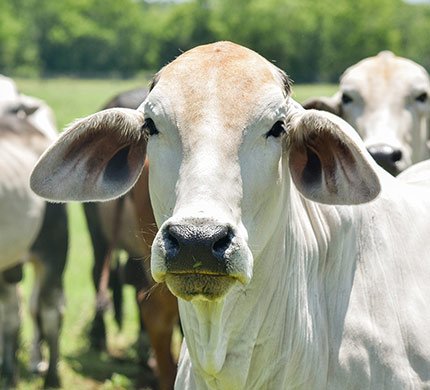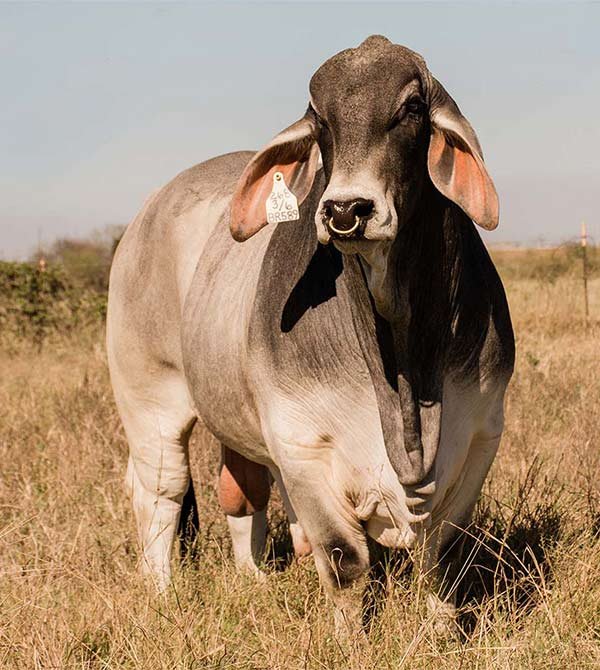Brahman
- Temperature:Hot and humid
- Milk:1,340 kg during a 216-day lactation
- Food:Grass and other vegetation
- Pregnancy:Approximately 9 months
- Nationality:India

General Information
Brahman cattle are a breed of beef cattle that originated in India and were introduced to the United States in the early 20th century. They are known for their distinctive hump on their shoulders, as well as their long, floppy ears and loose skin folds. Brahman cattle are well adapted to hot and humid environments and are prized for their heat tolerance and disease resistance.
They have a reputation for being hardy and adaptable and are often used in crossbreeding programs to improve the productivity and adaptability of other breeds. They can also be fed a variety of concentrates and supplements to improve their growth and productivity. Despite their relatively low milk yield, their milk can be used for making butter, cheese, and other dairy products.
Brahman cattle are raised for beef production around the world, including in the United States, Australia, and Brazil, and are a popular breed for their adaptability, hardiness, and disease resistance.
Where we find this cow to buy?
Brahman cattle can be found for sale from a variety of sources, including breeders, livestock auctions, and online marketplaces. There are many breeders who specialize in raising purebred Brahman cattle and can provide information about their bloodlines, breeding history, and health status.
Livestock auctions can also be a good source of Brahman cattle, as they often feature a wide variety of breeds and types of cattle for sale. Online marketplaces such as Craigslist, Facebook Marketplace, and various livestock classified websites can also be used to search for Brahman cattle for sale.
Before purchasing any cattle, it is important to research the seller and ask questions about the cattle’s health, history, and temperament. It is also important to consider factors such as transportation and housing before making a purchase.

How to increase milk production in Brahman?
Brahman cattle are known for their hardiness and adaptability to hot and humid climates. Here are some tips to increase milk production:
01
Provide a balanced and high-quality diet to the cows, with plenty of roughage and essential nutrients such as protein, energy, and minerals. Make sure the cows have access to clean water at all times.
02
Proper milking management practices can help to increase milk production in Brahman cows. This includes regular milking, maintaining good udder health, and ensuring that the milking equipment is clean and functioning properly.
03
Select Brahman cows that have high genetic potential for milk production. This can be achieved through careful breeding programs and selecting sires with high milk production genetics.
04
Ensure that the cows have access to a comfortable and clean environment with adequate ventilation and shade to help them cope with hot and humid climates.
Medicine
Brahman cattle, like all cattle, may require medical treatment from time to time to maintain their health and prevent or treat illness. Some common types of medicine used in Brahman cattle include:
01
AntibioticsAntibiotics are used to treat bacterial infections in Brahman cattle. They can be administered orally, through injections, or as a topical treatment.
02
Anti-inflammatory DrugsAnti-inflammatory drugs are used to reduce inflammation and relieve pain in Brahman cattle.
03
DewormersDewormers are used to treat internal parasites in Brahman cattle. They can be administered orally or as an injection.
04
VaccinesVaccines are used to protect Brahman cattle against various diseases such as bovine respiratory disease, leptospirosis, and infectious bovine rhinotracheitis.
Pregnancy
Brahman cows have a gestation period of around 283 days (approximately 9 months) and generally give birth to a single calf. During pregnancy, it is important to provide the cow with proper nutrition and management to ensure the health of both the cow and the developing fetus.
Here are some tips for managing pregnancy in Brahman cows:
Provide a balanced and high-quality diet to the pregnant cow, with plenty of roughage and essential nutrients such as protein, energy, and minerals.
Ensure the cow receives regular health care, including vaccinations, deworming, and other necessary treatments to prevent or manage disease.
Monitor the cow’s body condition, weight gain, and general health throughout pregnancy. Consult with a veterinarian if there are any concerns.
Monitor the cow and calf closely after calving to ensure both are healthy and receive any necessary care.
Important!
It is important to remember that milk production is influenced by many factors, including genetics, nutrition, and management practices. Therefore, it is important to take a comprehensive approach to increasing milk production in Brahman cows, and to consult with a veterinarian or animal nutritionist to ensure that all aspects of herd management are being optimized.
Food
Brahman cattle require a balanced and nutritious diet to maintain good health and support milk production, growth, and reproduction. The diet of Brahman cattle typically consists of:
Brahman cattle are well adapted to grazing on a variety of forages, including grasses, legumes, and other plant species.
In addition to forage, Brahman cattle may be fed concentrates such as grains, protein supplements, and minerals to supplement their diet.
Access to clean and fresh water is essential for Brahman cattle, especially during hot and dry weather when they may require more water than usual.
Facts
Here are some facts about Brahman cattle:
Brahman cattle are a breed of cattle that originated in India, specifically in the Brahmaputra River Valley in the northern region of the country.
Brahman cattle are known for their distinctive appearance, with a large hump over their shoulders and drooping ears.
Brahman cattle are known for their hardiness and adaptability to a wide range of climates and environments.
Brahman cattle are known for their longevity and can live up to 20 years or more.
Brahman cattle are generally known for their docile temperament, although individual animals can vary in behavior.
Brahman cattle are often used in crossbreeding programs to improve the hardiness and adaptability of other breeds of cattle.